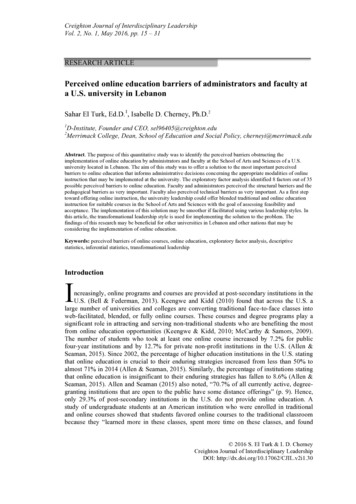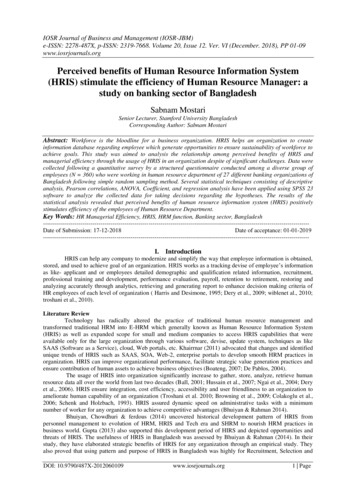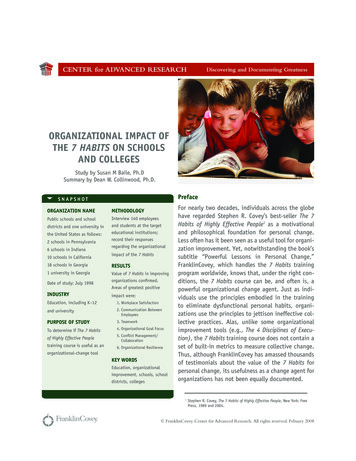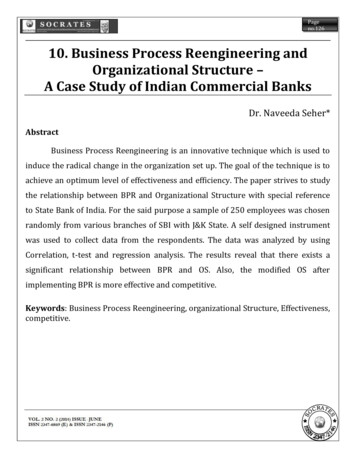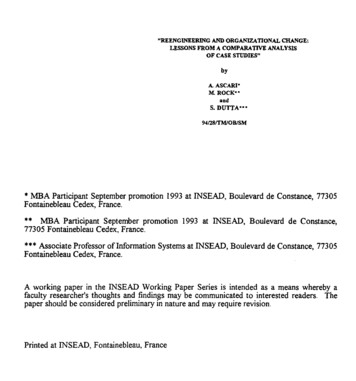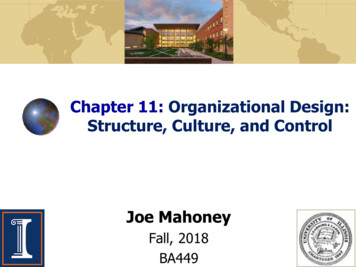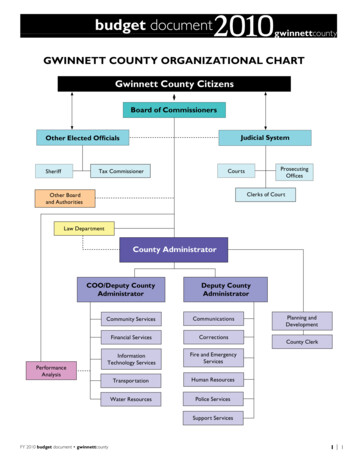
Transcription
Pak J Commer Soc SciPakistan Journal of Commerce and Social Sciences2015, Vol. 9 (1), 18-34Impact of Perceived Organizational Support onEmployee Retention with Mediating Role ofPsychological EmpowermentSehresh Iqbal (Corresponding author)Institute of Business and Management Sciences, University of Engineering andTechnology, Lahore, PakistanEmail: sehresh mass@htmail.comMaryam Saeed HashmiInstitute of Business and Management Sciences, University of Engineering andTechnology, Lahore, PakistanEmail: maryamhashmi57@yahoo.comAbstractObjective of this research is to study the effect of Perceived Organizational support atretention of employees with mediation of psychological empowerment in highereducational Institutions of Pakistan. Questionnaire of 31 items is adopted in which 8 itemscales is adopted to measure Perceived organizational support, 12 item scale to measurepsychological empowerment and 11 item scale to measure Employee retention. 200questionnaires were distributed, out of which 170 were returned. Analysis of data is doneby using SPSS 18 version. Findings of research document the existence of considerableand affirmative association of Perceived organizational support with employee retentionby partial mediation of psychological empowerment. In Pakistan this relationship isstudied for first time. This study is carried out in Pakistan where perceived organizationalsupport and psychological empowerment have been scarcely investigated andPsychological empowerment is entirely an ignored variable in this regard.Keywords: perceived organizational support, psychological empowerment, employeeretention, Higher Education Institutes (HEIs).1. IntroductionEducation is the supreme element which contributes significantly in human growth anddevelopment. Education is the pillar upon which highly developed cultures are fabricated.In order to strengthen that pillar it is essential to highlight the importance and to upgradethe quality of education. Without quality the pillar becomes a weak foundation anddeteriorates everything built upon it. The significance of effective teaching brought inlime light the overlooked issue of retaining good teachers. The academic professionalsare of crucial importance for effective performance of an institution. Academicinstitutions are unable to ensure sustainability and quality over the long period of timebecause of lack of competent and devoted academic staff. Therefore, higher educationalinstitutions are much more reliant on the academic and creative abilities and commitmentof their academic staff than in any other organizations. According to Ng’ethe et al.
Iqbal and Hashmi(2012), universities serve as storehouse of knowledge for development of human resourceneeds consequently gratifying the ambition and desire of the nation for superior andbenevolent civilization.Pienaar and Bester (2008) strongly argue that academic profession is elementary foreffective operation and performance of universities. Any academic institution cannotsurvive and perform well without competent and committed academic staff. Thereforeuniversities are more reliant on the scholarly and ingenious abilities and loyalty of thefaculty in comparison of the other institutions. Anderson, et al. (2002) states that inAustralian universities 68% of the university staff desired to leave higher education .As79% and 71% of the respondents considers the value of academic profession isdilapidated. South African universities are also confronting same challengingcircumstances, where between 5% and 18% academic staff switched off from highereducation institutions. Yousaf (2010) examines the renowned challenges regardingacademic staff retention experienced by developed states. For instance in case of UnitedStates within one academic year from 1997 to 1998, 7.7% of the full time faculty switchto other jobs, out of which only 29% are retirees and rest of the 71% left for variety ofreasons.It has been observed that retention of proficient and competent teachers has become astumbling block in improving quality of education for Higher Education Institutions(HEIs) in Pakistan as the turnover rate has been significantly increased in recent years. Inhigher education institutions, which are considered as the hub of knowledge, the retentionof knowledge-workers has become a crucial issue.According to Aycan, et al. (2000), Pakistan is one of the countries where education sectorhas been a neglected rubric with respect to human resource management. Khuwaja(2012) states that Human resource management is generally an ignored variable in ourPakistani educational sector and need alarming attention in era of competition andglobalization. High turnover leads to monetary loss, for example cost for recruiting newstaff for replacement, training cost, cost associated with period prior to intentional exitfrom university as in that time teacher will be less productive and public relation cost.According to Zahra, et al. (2013), with increase in number of universities, thecharacteristics of business of education are also changing. One of the most importantfactors is the commercialization of education. This paradigm shift leads to high turnoveramong academic staff because now they have ample opportunities, on basis of which theycan conveniently select the institutions according to their own preferences andsatisfactory factors. According to Zhou and Volkwein (2004), when faculty quit,university will bear the loss at individual, departmental and institutional level and alsoaffects negatively the goodwill of institution and availability of services. A large numberof universities of Pakistan are predominantly affected with issue of high turnover becausein order to cope up with our vigorously shifting business settings universities are undermounting stress to produce graduates even when the availability of skilled faculty islimited. Therefore universities have to handle these changes and deal with the issue ofturnover.19
Perceived Org. Support, Employee Retention and Psychological Empowerment1.1 Impact of HEC ReformsHEC is responsible to make sure the availability of fair and accessible higher educationof International standards. HEC of Pakistan introduces the changes which lead to anincrease in number and nature of educational Institutions. One of the most important factsis that Education sector is highly privatized, consequently now faculty is available withmultiple choices to accept or reject the institutions. This makes retention of professionaland qualified teachers, a significant challenge for higher education institutions inPakistan. According to Osama, et al. (2009), in last five years HEC have introducedfollowing key initiatives Awarding 2,825 scholarships for development of academic staff with associationsof doctorate from developed states Introduce Foreign Faculty Hiring Program (FFHP), under which foreign facultymembers are offered with internationally equivalent salaries, joining of 289faculties from abroad under Tenure Track System (TTS).Moreover new policies are formulated for hiring of faculty members like from Jan 1,2015, the eligibility criteria for appointment of a lecturer in universities will beM.Phil./MS or equivalent degree (18 years) or degree in master from a foreign university.Similarly from Jan 1, 2016 eligibility for appointment of an assistant professor in highereducational institution will be PhD. Due to all these above mentioned facts, severecompetition in educational structure with respect to gaining knowledge and deliveringtoo, and dissatisfaction with respect to salary ranks, there is a challenge for universities tomaintain faculty over a longer period of time especially new hires and providing themsystematized structure as per HEC requirement. (HEC, 2012)2. Literature Review2.1 Perceived Organizational SupportChen (2010) states that perceived organizational support gets high consideration since1980s.Krishnan and Mary (2012) defines Perceived Organizational support as sensitivityand opinion of employee regarding the degree to which their involvement is appreciatedand recognized by their institution and cares about their well-being .According to WannYih and Hatik (2011) perceived organizational support is an employee’s point of viewregarding the extent to which organization is concerned for their welfare and consider itsefforts for organization. They put more efforts when there is an indication that all effortswill be owned and will be rewarded by organization. Waseem (2010) found that the jobattitudes and behavior of employees is highly affected by different institutional policiesand programs which ultimately leads to positive organizational outcomes. It is the beliefof an employee that the organization considers their effort in accomplishment oforganizational goals. Therefore employees always engage themselves in activities whichkeep them close and respected to their employer. Ghani (2006) stated that employeeslead to organizational success. According to Colakoglu, et al. (2010) organizationalsupport is of great importance for employees and considered by employees as key factorwhich also enhances the job satisfaction and the organizational commitment ofemployees.20
Iqbal and Hashmi2.2 Psychological EmpowermentSpreitzer (1995) defines the Psychological empowerment as a set of motivationalthoughts or ideas shaped by a work environment and reflecting an individual’s activeorientation to his or her work role. It has four components: meaning, competence, selfdetermination and impact. Meaning refers to that how much a task is worth able inrelation to individual belief system. According to Zhang and Bartol (2010) meaningrefers to the importance of a job a sense of personal connection to work. Competencerefers the extent to which an individual is talented to execute an undertaking successfullywith all his possessed skills and abilities; Impact refers the extent to which an individualcan influence the work ending; Self-determination refers that how much an individual haspower, independence and self-sufficiency over his day to day job tasks.Employees with high level of self-determination possess the ability to affect theindividuals and organization more, positively.Bhatnager (2012) in his study found that psychological empowerment significantlyeffects the commitment of employee toward his Institution. With an increase in intensityof psychological empowerment turnover intention will get lowered down and employeewill feel more autonomous at their job. Kraimer, et al. (1999) and Spreitzer (1995) haveassociated psychological empowerment with different outcomes, including organizationalcommitment and Applebaum et al. (2003), states that commitment is significantcontributor in employee retention strategies of an organization.2.3 Employee RetentionEmployee retention is defined by Akila (2012) as a course of action in which theemployees are expectant to be part of institution for the maximum period of time or untilthe accomplishment of job. Retention of employees is valuable equally for employees aswell as for organization. When employees feel dissatisfied they will switch over to thebetter opportunity. Therefore task of employer is to retain valuable and talentedemployees otherwise they will be left with no good employee. Nazia and Begum (2013),defines employee retention as a business effort to retain its current staff by sustaining asupportive working environment. The purpose of various employee retention policies isto enhance the job satisfaction which adds to retention rate and trim down theconsiderable expenses associated with employing and guiding fresh personnel.According to Samuel and Chipunza (2009), purpose of retention is to prevent the lossbeard by Institutions in case when employees quit from their job and it negatively effectsproduction and prosperity.2.4 Relationship between Perceived Organizational Support and Employee RetentionAccording to Godfrey (2010), those employees will be more committed and will decideto be part of organization for long period of time that think that their organizationappreciates their efforts for organization and cares about their comfort and welfare.Perceived organizational support is negatively associated with turnover intentions. Samefindings are also explained by Allen, et al. (2003), which showed that high scores on POSwas associated with low scores on turnover intentions and actual turnover.21
Perceived Org. Support, Employee Retention and Psychological Empowerment2.5 Relationship between Perceived Organizational Support and PsychologicalEmpowermentAccording to Ahmad, et al. (2010), explains that it is the general point of employees thatthey feel psychologically more empowered at their workplace when they haveorganizational support. Employees with perceived organizational support are morecertain and positive that they have all of the resources required to perform their jobefficiently, appreciation for their efforts and organizational association for their actions.According to Patrick and Laschinger (2006), perceived organizational support andpsychological empowerment are positively related with each other2.6 Relationship between Psychological Empowerment and Employee RetentionAccording to Mendes and Stander (2011), for financial stability it is very much importantto empower and retain the employees. Mangers need to understand that howempowerment motivates the employees to remain part of organization .According toKlerk (2013), there exist significant relationship between psychological empowermentand retention. He found that it would be valuable if organizations develop skills inleaders to empower their workforces. This would lead to higher levels of psychologicalempowerment, work engagement and retention of talent.Literature is highly enriched with variety of variables which contributes in facultyretention both in local and in international context. According to Tetty (2006), Zahra.,etal. (2013) and Mubarak,
Questionnaire of 31 items is adopted in which 8 item scales is adopted to measure Perceived organizational support, 12 item scale to measure psychological empowerment and 11 item scale to measure Employee retention. 200 questionnaires were distributed, out of which 170 were returned. Analysis of data is done by using SPSS 18 version. Findings of research document the existence of
